Trying to come up with the right approach to play through an opponent is never easy. It’s not only about theory: an important part of the plan is choosing the players to execute it.
Unai Emery’s choices in midfield complemented the attacking approach in Aston Villa’s 2-1 victory against Manchester City on Saturday.
By starting John McGinn, Youri Tielemans and Morgan Rogers behind Jhon Duran, Villa had three players who don’t lose the ball under pressure, can carry it forward or pick their pass, and know how to attack the space.
The profiles of McGinn, Tielemans and Rogers fit how Villa wanted to attack. “We needed to connect with our No 8 and No 10 when we were building up and Morgan — and McGinn and Tielemans — were doing a fantastic job,” said Emery after the match. “Morgan’s drives are fantastic and broke the lines and we could get in their box through him.”
Villa built up their attacks in a 4-2-3-1 shape, with McGinn, Tielemans and Rogers positioned narrowly between the lines.

Against City’s 4-1-4-1 out-of-possession shape, Emery’s side wanted to find Tielemans and Rogers behind the opponent’s midfield as the duo overloaded Mateo Kovacic.
Tactics aren’t only about the ideas and the profiles of the players, it’s also about the execution. Tielemans and Rogers knew how to be a threat between the lines.
Here, Kovacic is tracking Rogers as Emiliano Martinez plays the ball to Lucas Digne towards the touchline. Tielemans is free in midfield…

… and as the ball reaches Villa’s left-back, he moves towards the action to provide an option between the lines. Digne heads the ball towards Rogers…

… and as the midfielder plays it back to Pau Torres, Tielemans positions himself in the space Kovacic has vacated to provide a passing option and maintain a distance from City’s centre-backs.

Tielemans’ movement allows Torres to find him behind City’s midfield…

… and Manuel Akanji moves up towards the midfielder, who dribbles past him with ease. Meanwhile, Duran attacks the space Akanji vacated and Boubacar Kamara dashes forward to support the attack.

Tielemans finds Kamara’s run, with Duran and McGinn in position to attack the space. Kamara then plays the ball wide to McGinn and the latter finds Matty Cash’s overlapping run, but the right-back’s shot hits the side netting.

In another example, McGinn, Tielemans and Rogers are in their narrow positions.
Kovacic is marking Rogers as Villa’s centre-backs are building up the attack. When Torres plays the ball to Ezri Konsa…

… Tielemans adjusts his position to provide the centre-back a passing option and he attacks the space Rico Lewis and Josko Gvardiol are hesitant to defend because of McGinn.
Konsa then finds Tielemans between the lines…

… and the midfielder’s pass to Duran is ruled offside. However, it’s important to note Rogers’ run, which could have been another option for Tielemans.

When Villa were building up, Tielemans regularly dropped to distance himself from City’s centre-backs, even before receiving the pass.
In this example, Kyle Walker tracks Rogers, but Savinho changes markers as Martinez is playing the ball to the Villa forward. At the same moment, Tielemans is dropping to distance himself from Gvardiol…

… and force the centre-back into an uncomfortable position.
Rogers’ ball-carrying ability allows him to roll Savinho and Tielemans attacks the space opposite to the forward’s run. This way, Gvardiol is put in a situation where he either has to defend Rogers or track Tielemans’ movement — and to make things worse, Kamara is advancing from midfield.

Gvardiol holds his position, but his wrong body orientation allows Rogers to find Kamara, with Tielemans moving in the other direction.

Kamara plays the ball into Tielemans’ path and the significance of the midfielder’s run is that it drags Walker inside the pitch, which allows Digne to attack the space freely.

However, Tielemans isn’t able to switch the play towards the left-back.
Meanwhile, Rogers surges forward to attack the space…

… which creates a two-versus-one situation towards the far post when Tielemans plays the ball wide to McGinn. But McGinn’s cross doesn’t find Rogers or Digne and it’s closer to Walker, who clears it.

Again, it’s a similar scenario with Kovacic tracking Rogers and Tielemans dropping to distance himself from City’s centre-backs.
Villa combine through Torres to find Rogers near the touchline…

… and Rogers plays the ball to Tielemans in space…

… which moves Gvardiol out of position. Tielemans returns the pass and Rogers beats Walker to the ball…
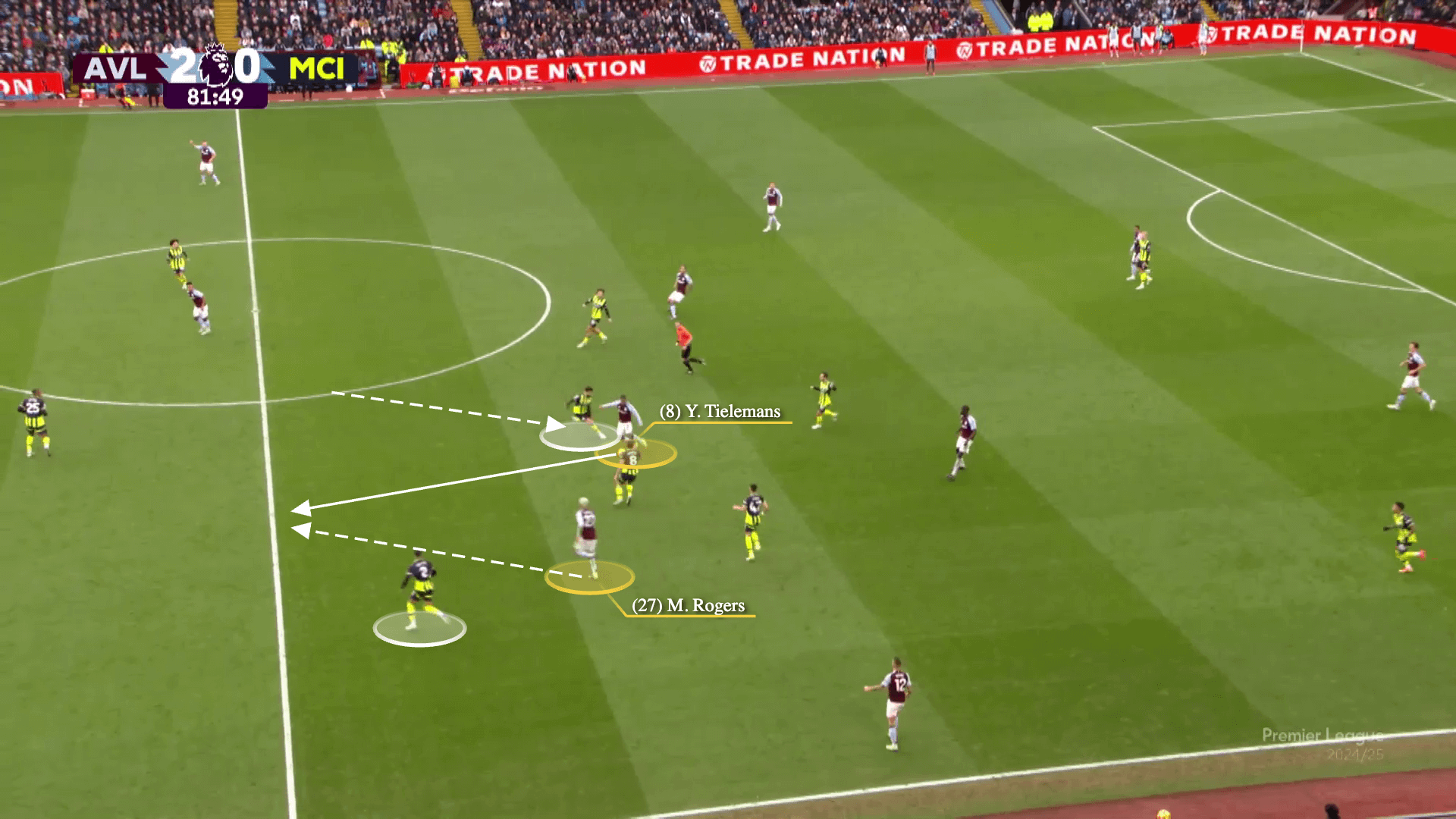
… before putting Ollie Watkins in front of goal, but the striker’s shot is saved by Stefan Ortega.


In the second half, Villa managed to play through City on multiple occasions, but it was their first successful attempt in the match that led to the opener.
Here, Kovacic is again marking Rogers and Tielemans drops to distance himself from John Stones, even before Martinez plays the ball into the midfielder.

The moment Tielemans receives the ball, Rogers moves behind Kovacic…

… which gives Rogers a head start and allows the Belgium midfielder to find him in space. In addition, Duran’s positioning moves Akanji away from that space…
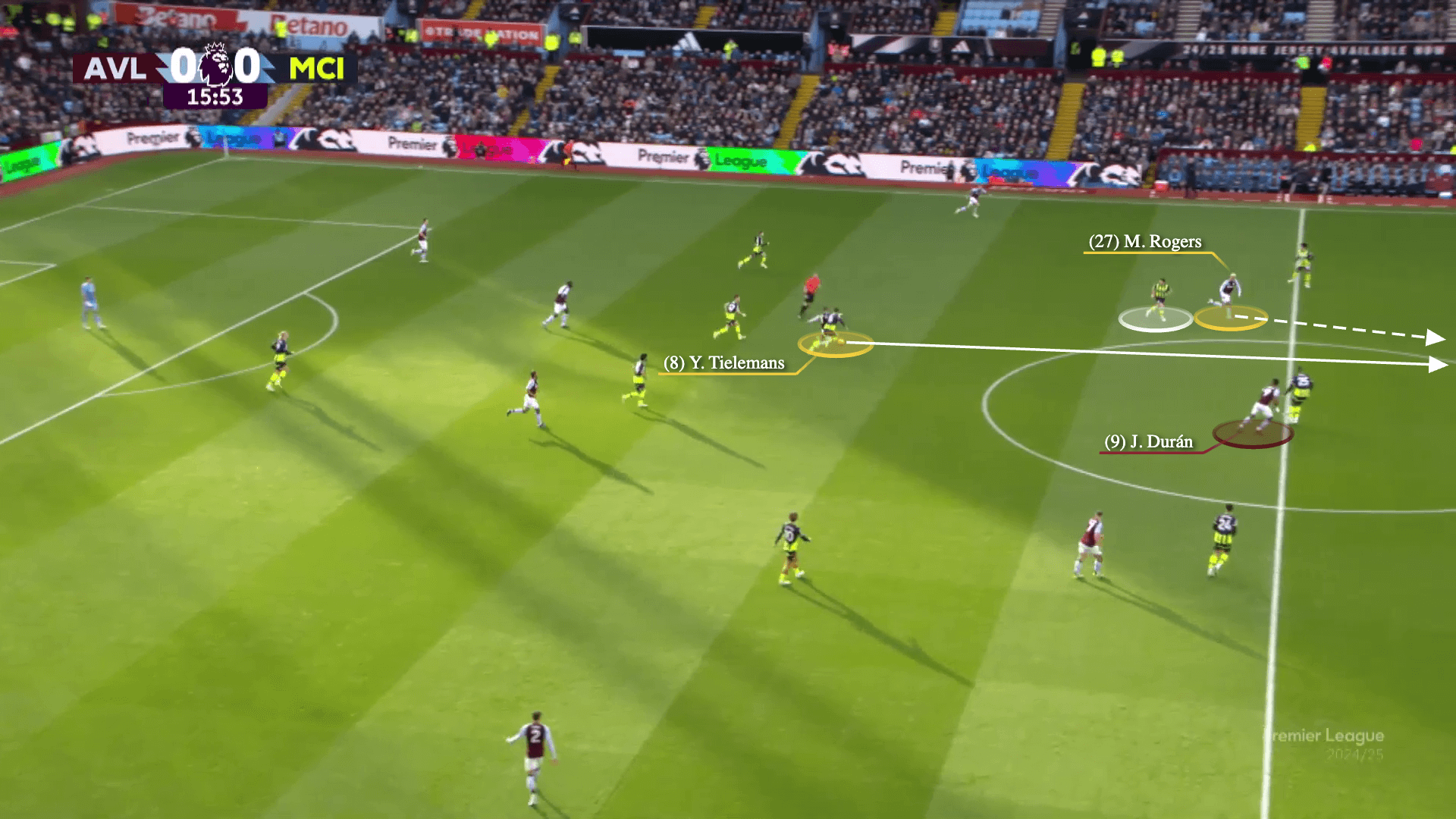
… and allows the centre-forward to be a passing option. Rogers then plays the ball into Duran’s path and the striker scores to make it 1-0.

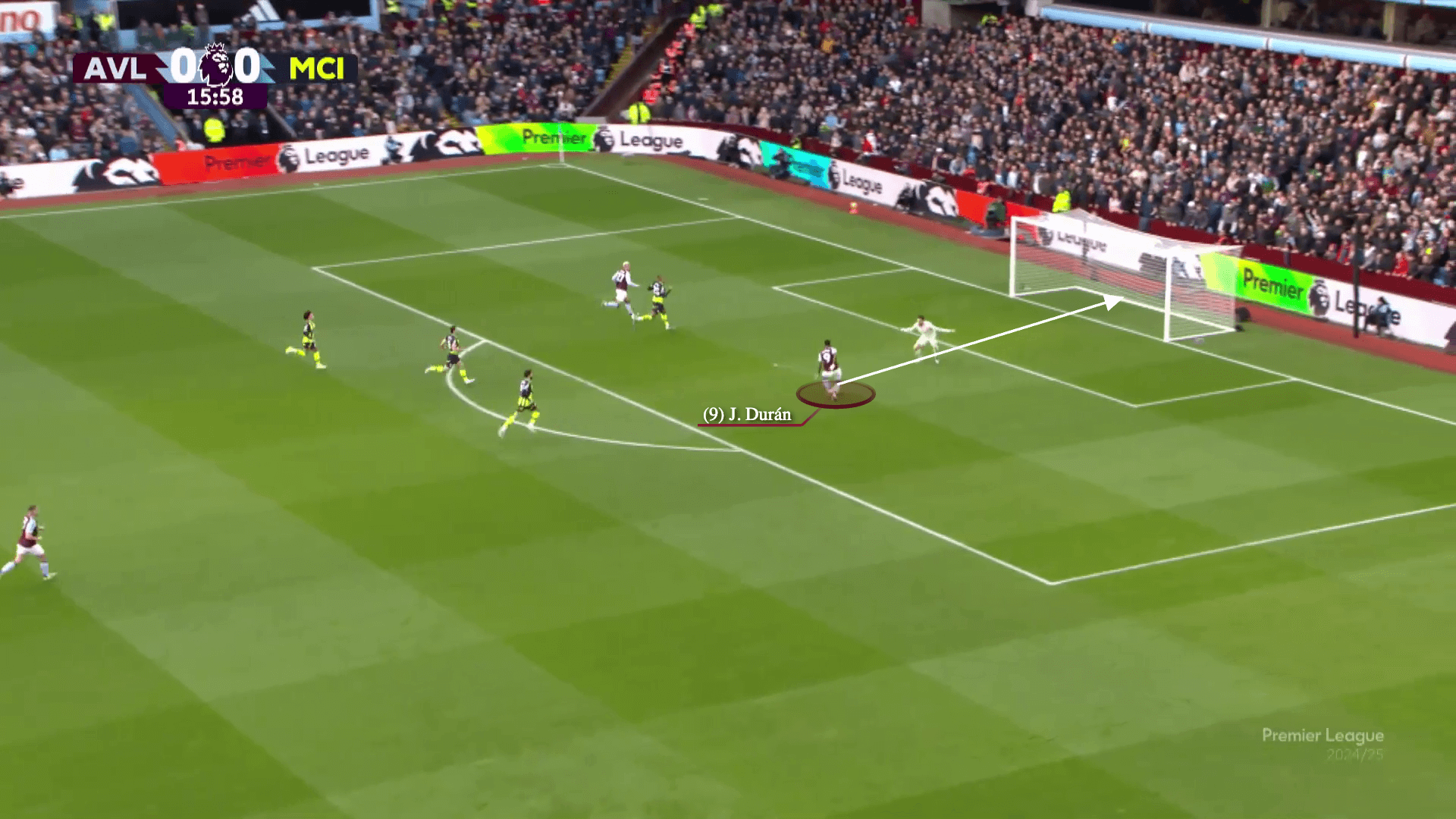
“I give more credit for Aston Villa making the action (on the first goal),” said City’s manager, Pep Guardiola, after the match. “In the second half, we weren’t as aggressive like in the first half and they arrived more times in our box.
“They make a lot of passes, they link diagonal balls behind our holding midfielder with Tielemans, Duran or Morgan in that position.
“I give credit because the opponents are good. When you go one or two duels, they dribble, they keep the ball. You go to McGinn, they dribble you. Go to Morgan, they dribble you.”
That was the case on Villa’s second goal. In the build-up, Rogers drops behind City’s midfield to offer a passing option…

… and when Torres finds him, Tielemans is unmarked on the other side with Lewis in no man’s land. Rogers’ position forces Walker to move up…

… and the Villa player receives the ball with his left foot and dribbles with his right to roll City’s right-back.
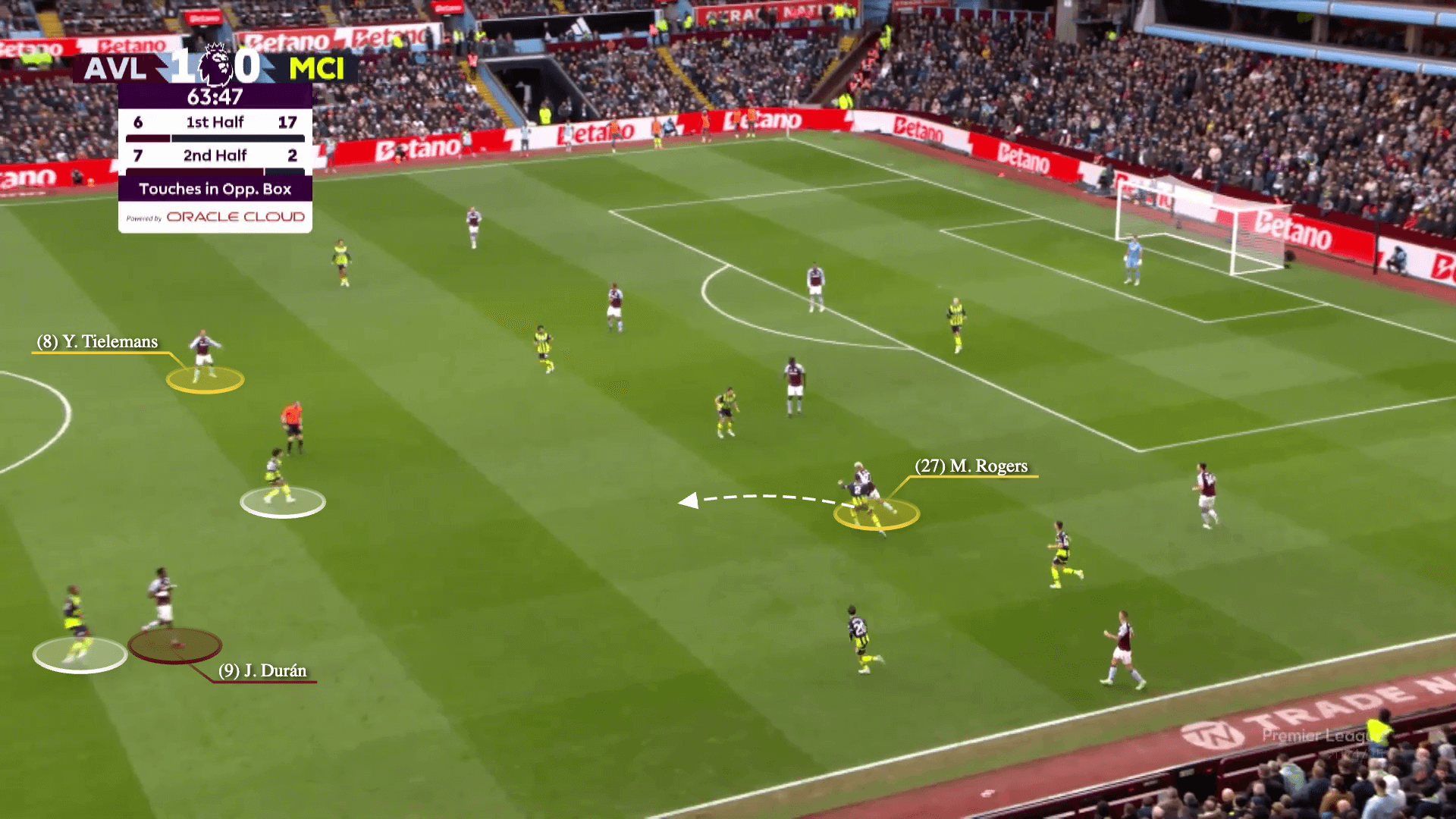
Duran’s movement creates a bigger space for Rogers to dribble into as the centre-forward moves Akanji away. Meanwhile, Lewis can’t mark Tielemans because he has to drop and defend that space.

Rogers then plays the ball wide to McGinn…

… and the unmarked Tielemans makes an overlapping run, which attracts Gvardiol and forces Lewis to defend McGinn.
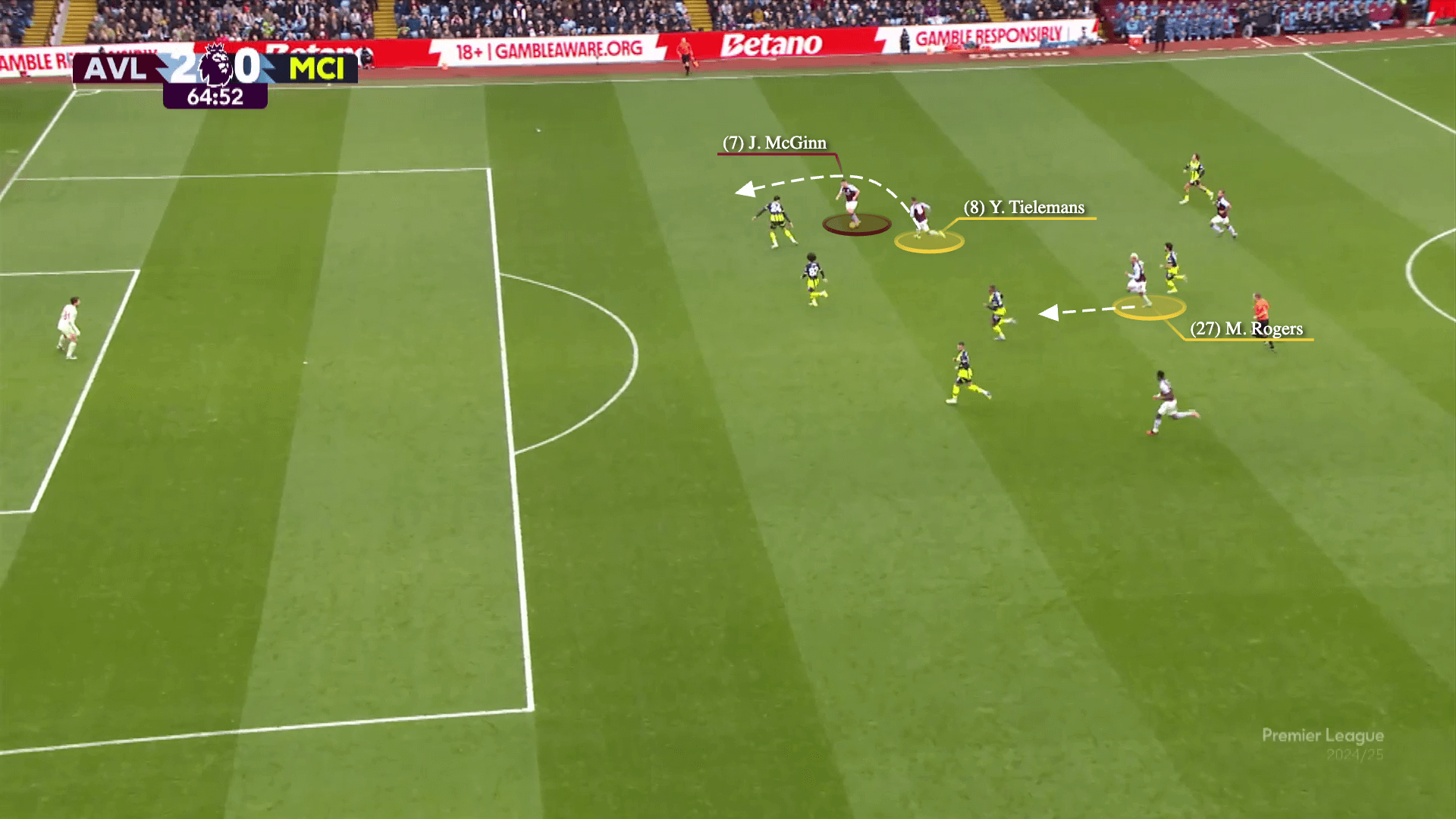
With Duran occupying Akanji and Walker, McGinn finds Rogers near the edge of the penalty area…

… and the latter strikes the ball into the far bottom corner to double Villa’s lead.

Emery had the right plan by using Tielemans, Rogers and McGinn in narrow positions. His choices, in terms of the characteristics of the players, strengthened the plan and the execution turned theory into art.
(Top photos: Getty Images)





